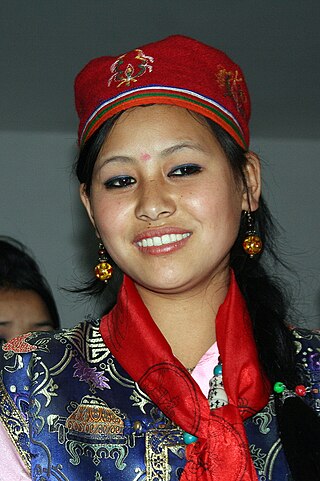A topi is an antelope species of the genus Damaliscus . The word is used for the species D. lunatus in general, but has also been restricted to D. lunatus jimela. The subspecies D. lunatus topi is also called topi.
Contents
Topi may also refer to:
A topi is an antelope species of the genus Damaliscus . The word is used for the species D. lunatus in general, but has also been restricted to D. lunatus jimela. The subspecies D. lunatus topi is also called topi.
Topi may also refer to:

The fez, also called tarboosh, is a felt headdress in the shape of a short cylindrical peakless hat, usually red, and sometimes with a black tassel attached to the top. The name "fez" refers to the Moroccan city of Fez, where the dye to colour the hat was extracted from crimson berries. Despite its name, the original centre of production appears to have been in Tunis, not Fez. The modern fez owes much of its popularity to the Ottoman era.

The pith helmet, also known as the safari helmet, salacot, sola topee, sun helmet, topee, and topi) is a lightweight cloth-covered helmet made of sholapith. The pith helmet originates from the Spanish military adaptation of the native salakot headgear of the Philippines.

A kufi or kufi cap is a brimless, short, and rounded cap worn by men in many populations in North Africa, East Africa, West Africa, and South Asia. It is also worn by men throughout the African diaspora. It is also commonly called a "topi" or "tupi" in the Indian subcontinent.

Pakol is a soft, flat, rolled-up, round-topped men's cap, usually worn in northern South Asia. It is typically made of wool and found in a variety of earthy colours, such as brown, black, grey, ivory, or dyed red using walnut. The Pakol is believed to have originated in Chitral, or Gilgit-Baltistan in Pakistan.

The Dhaka topi, or Nepali topi, is a hat which is popular in Nepal, and which forms part of Nepalese national dress, worn by men on celebrations.

The pileus was a brimless felt cap worn in Ancient Greece, Etruria, Illyria (Pannonia), later also introduced in Ancient Rome. The pileus also appears on Apulian red-figure pottery.

Aeschynomene aspera is a species of flowering plant in the family Fabaceae. It is also known by the names sola, sholasola pith plant, pith plant, laugauni (Hindi) ponguchedi (Malayalam) or Netti (Tamil). Pith of low density from this plant is used to make hats known as pith helmets or sola topis.
Pakistani clothing refers to the ethnic clothing that is typically worn by people in the country of Pakistan and by the people of Pakistani origin. Pakistani clothes express the culture of Pakistan, the demographics of Pakistan, and cultures from the Punjab, Sindh, Balochistan, Khyber Pakhtunkhwa (Pashtun), Gilgit-Baltistan, and Kashmir regions of the country. Dress in each regional culture reflect weather conditions, way of living, and distinctive style which gives it a unique identity among all cultures.

The Taqiyah or araqchin is a short, rounded skullcap. It is often worn for religious purposes; for example, Muslims believe that the Islamic prophet Muhammad used to keep his head covered, therefore making it mustahabb. Muslim men often wear them during the five daily prayers.
Sholapith or shola pith is a dried milky-white spongey plant matter from Aeschynomene species. It can be pressed and shaped into objects of art, or for practical use. It is the "pith" used for pith helmets, so giving them their name.

Headgear, headwear, or headdress is the name given to any element of clothing which is worn on one's head, including hats, helmets, turbans and many other types. Headgear is worn for many purposes, including protection against the elements, decoration, or for religious or cultural reasons, including social conventions.

Shalwar kameez is a traditional combination dress worn by women, and in some regions by men, in South Asia, and Central Asia.
Dasht-e Yahudi is a historic region referred to by Persian and early Mughal historians that comprises the most western parts of modern-day Peshawar, Charsadda, Malakand and Mardan districts, particularly around their border areas with the Khyber and Mohmand districts. While the region is not a desert, it does have a semi-arid climate.

Both Sindhi women and men wear the shalwar qameez or the kurta with pyjama. Women wear sari or ghagra. However, before the adoption of the Shalwar kameez and the kurta, the sari as well as other articles of clothing, Sindhis had their own traditional costumes.

The traditional clothing worn in Khyber Pakhtunkhwa varies according to the area of the region. The following outfits are generally worn in the area.

A Bhaad-gaaule Topi or Black Cap is a type of hat, popular in Nepal, specially in Newari Community. It is a type of black cap/topi, especially made in the towns of Bhadgaon or Bhaktapur in Nepal, and a part of Newari traditional dress. This has been adopted as a part of Nepali national dress for men, as an alternative to the Palpali Dhaka topi.

The Royal Marines uniform is the standardised military dress worn by members of the Royal Marines.

The Birke topi, birkhe topi or Bhanubhakta-styled topi is a traditional cap worn in the western hilly region of Nepal. It was popularized by the poet Aadikavi Bhanubhakta Acharya.

Shyade or TamangTagi is a woolen cap worn by the Tamang people of Nepal. It is a part of the traditional dress of the community. The hat is unisex and is worn by people of all age groups.